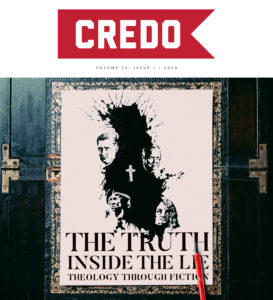Of all the great books, why read and reflect on Moby-Dick?
Nathaniel Philbrick gives one compelling answer: “Reading Moby-Dick, we are in the presence of a writer who spent several impressionable years on a whaleship, internalized everything he saw, and several or so years later, after internalizing Shakespeare, Hawthorne, the Bible, and much more, found the voice and the method that enabled him to broadcast his youthful experiences into the future.” [1]
Herman Melville’s ‘broadcast’ is worthy of reading and reflection, not only for its content and characters, but also for its construction. It is The. Great. American. Novel. For the Christian reader, it is also valuable for what R. C. Sproul identified as its “unparalleled theological symbolism.” [2]
In my own reading of Moby-Dick, I attempt to read it for what it is, a work of art. In this short reflection, therefore, I ask and answer three questions I’ve developed, to help me as a Christian, guide my observation of works of art, whether in painted, composed, or written forms—and regardless if the art was specifically created to illuminate truth revealed in the Bible or truth revealed in creation. [3]
How Does Moby-Dick Glorify God?
To read Moby-Dick is to encounter many new areas of knowledge that appear tangential or skippable. There are chapters that cover biology, geography, nautical intricacies, and more information about whales and the use of whales in the 19th century than you might imagine.
It is said, if you want to learn about 19th century sewer systems, read Les Misérables; if you want to know all there is to know about whales, read Moby-Dick. [4]
Yet, while in the middle of reading, it may seem tangential, the details all serve a purpose—Melville is driving you toward a final battle with the White Whale, and one cannot appreciate the magnitude of that battle, in full, without first going on his instructional journey.
Likewise, a comparison can be made to how we read the Bible, especially the Old Testament. To read the Bible is to encounter many new areas of knowledge that might appear tangential or skippable. There are chapters on genealogy, indices of laws, detailed descriptions of movements of people, lengthy poetry and prophecy—instructions we may not fully understand.
Yet, when “reading through the Bible,” while some parts may seem tangential, they do serve an ultimate purpose. God, through his authors, is driving you toward his Christ—and one cannot appreciate the magnitude of his life, death, and resurrection, in full, without first going on this instructional journey.
The reading of the Great American Novel glorifies God as it reminds the believer of The. Greatest. Story. and reminds regularly that something greater than Melville speaks, rules, and reigns. The reading of the Great American Novel glorifies God as it reminds the believer of The. Greatest. Story. and reminds regularly that something greater than Melville speaks, rules, and reigns. Share on X
What is Good, True, and Beautiful About this Work?
Melville’s experience and knowledge of the world about which he writes points to much that is good, true, and beautiful. Whether it is the depiction of the relationship between friends and shipmates, the telling of the intricacies of biology and the effects of the fall on creation, or the sublime portrait of a beautiful sea, Moby-Dick resonates because it echoes much of what the reader knows is good, true, and beautiful.
Consider even the trivial description Melville gives of Nantucket chowder served on the eve of Ishmael’s departure:
“It was made of small juicy clams, scarcely bigger than hazel nuts, mixed with pounded ship biscuit, and salted pork cut up into little flakes; the whole enriched with butter, and plentifully seasoned with pepper and salt …. [W]e despatched it with great expedition.”[5]
The reader can resonate (and salivate) with the author’s care for presenting one of the main character’s last meals on land as a good and beautiful thing.
Further, there is the concluding example of the chief mate, Starbuck, who functions as a voice of conscience for the crew and in contrast to the deranged captain. Even after voicing opposition and a desire to abandon the fool’s errand of chasing the White Whale, Starbuck loyally serves. Near the tragic end, after the famous cry is made of “There she blows!—there she blows!” [6] and a three day chase ensues, Starbuck murmurs to himself reflecting on his choices, “I misdoubt me that I disobey by God in obeying [Ahab]!” This leads to one last moment of courage as Starbuck pleads, “Oh! Ahab, not too late is it, even now, the third day to desist. See! Moby Dick seeks thee not. It is thou, thou, that madly seekest him!” [7]
Starbuck’s lent hand is not returned and all is soon lost, but even in the telling, Melville’s story allows the Christian to see the truth of the gracious presence of the human conscience that leaves no one with an excuse (Rom 2:15).
What can I Appreciate About the Talents and Techniques Used by my Fellow Human Being, the Author?
Herman Melville’s Moby-Dick is one of the greatest novels, and for good reason. Melville writes in such a way that you have to stop just to marvel at the way he crafts a sentence. Even Pulitzer Prize-winning author, Marylinne Robinson, is left without many words when describing Melville,
“What can we say? He had a gift.” [8]
As just one example is the meditation Melville gives of a wooden pulpit. Prior to his setting to sea, Ishmael visits the Whaleman’s Chapel and ponders at length the pulpit standing before him. Melville writes in such a way that you have to stop just to marvel at the way he crafts a sentence. Share on X
What could be more full of meaning?—for the pulpit is ever this earth’s foremost part; all the rest comes in its rear; the pulpit leads the world. From thence it is the storm of God’s quick wrath is first descried, and the bow must bear the earliest brunt. From thence it is the God of breezes fair or foul is first invoked for favorable winds. Yes, the world’s a ship on its passage out, and not a voyage complete; and the pulpit is its prow. [9]
This telling of the narrator’s own reflection is a small section at the start of the novel, but it reveals the care and carefulness Melville gave to every chapter. The reader could read only one chapter a day and still read Moby-Dick too quickly.
Yet, again, for the Christian reader, the enjoyment of Melville’s prose is a natural opportunity to reflect on the even more majestic and glorious words of inerrant Scripture.
When one reads through the Bible, inspired as it is by God Himself, one often needs to stop just to marvel at the words and the One they describe—his might, his mercy, his mystifying patience—his character.
Thus, a reflection on the Great American Novel can lead the Christian, with ease, to think and be thankful for our Great God.
What can we say, He is a gift.
[1] Nathaniel Philbrick, Why Read Moby-Dick? (Penguin Books, 2013), 70.
[2] R. C. Sproul, “The Unholy Pursuit of God in Moby-Dick,” Tabletalk, August 1, 2011.
[3] See Jason G. Duesing, “The Christian, Art, and Rediscovering John the Baptist,” For the Church, October 10, 2019.
[4] For more introduction to the reading of Moby-Dick see Nathaniel Philbrick, Why Read Moby-Dick?; R. C. Sproul, “The Unholy Pursuit of God in Moby-Dick”; James Hamilton, “Tenants, Traps, Teaching, and the Meaning of Melville’s ‘Moby-Dick,’” For His Renown, June 14, 2011; Connor Grubaugh, “James and Melville, Two American Minds,” First Things, February 2, 2018.
[5] Moby-Dick, Chapter 15.
[6] Moby-Dick, Chapter 133.
[7] Moby-Dick, Chapter 135.
[8] Drew Bratcher, “Reading Moby-Dick with Marylinne Robinson,” The Gospel Coalition May 1, 2018
[9] Moby-Dick, Chapter 8.
Photo credit: Abhilash Ramachandran


